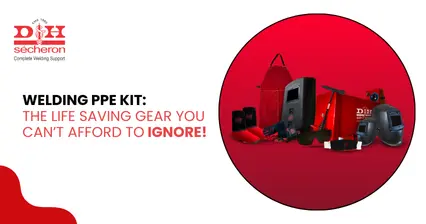The selection of an electrode can be quite challenging as there is ‘no one size fits all’ rod that can be used in all applications. Certain factors can help you with the selection of the best mild steel electrode. Here is all you need to know.
Base Metal
The base metal is also known as the parent metal. The electrode metal should match the chemical and mechanical properties of the base or parent metal.
It ensures a strong and stable weld. So, if the base metal is mild steel, the electrode should also be mild steel or at least a close match. If there is a substantial difference in the match, there is a risk of cracking and other welding abnormalities.
Even the thickness of the base metal is important. If the base metal is thin, you should select an electrode with a soft arc with a smaller diameter and shallow penetration. On the contrary, an electrode with a digging arc and deep penetration power would be a better option.
The tensile strength is another factor to consider in base metal. The tensile strength refers to the breaking strength of a material when it is put under tension. It is the ability of the metal to withstand pressure without breaking when maximum load is put on it. When selecting the electrode, make sure that its minimum tensile strength is similar to that of the minimum base metal. The tensile strength of an electrode is usually printed on the electrode or its packaging.
Welding Position
The welding position is the direction in which the welder lays out the welding bead. The gravity also impacts the flow of molten filler material during the welding position. There are four types of welding positions - flat, horizontal, vertical and overhead.
Most mild steel electrodes are often labelled as all-position electrodes. However, each electrode is qualified for a specific position only, or else it could result in welding issues.
Hence, it would help if you always chose a mild steel electrode that fits the welding position of the application.
Welding Current
Electrodes run on Alternative Current (AC) or Direct Current (DC). AC and DC indicate the polarity of the current in the welding machine and electrodes.
If electrodes are AC specifications, then the polarity will change. If electrodes are labelled DC, then the polarity will remain constant. Electrode-positive has reversed polarity due to which deeper penetration is possible in welding. Electrode-negative has a straight polarity which leads to faster melting of the electrode during the welding.
When you choose a mild steel electrode, you should check for its current compatibility.
Other Factors
There are a few more factors that affect the choice of an electrode:
Type of application
Welding cost
Joint preparation
Welding quality and finish
Environmental job conditions
Electrodes are available in varying specification and quality. You should find the best one suited to your welding requirements. It is also recommended to buy them only from reputed manufacturer and supplier brands.
11 May 2025 | Welding
An In-Depth Exploration of Low-Alloy Steel: Your Comprehensive Guide
11 May 2025 | Welding
Nagpur - Bori - Tuljapur Road MSH-3 in Yavatmal District (Maharashtra)
11 May 2025 | Welding
Guidelines to Understand Gas Welding: Applications, Advantages & Disadvantages
11 May 2025 | Welding
How to Select the Right Welding Filler Wires for Stainless Steel Welding?
11 May 2025 | Welding
Building the Narendra Modi Stadium with Norma V and Autotherme-1 Electrodes
11 May 2025 | Welding
Low Alloy Steel Welding in a (PEB) Pre Engineered Building Structure
11 May 2025 | Welding
Welding Rods: Different Types and Tips for Properly Storing and Handling
11 May 2025 | Welding
Tips for Flawless Welds with Stainless Steel Electrodes: Pros and Cons
11 May 2025 | Welding
Exploring Applications and Benefits of Stainless Steel Welding Electrodes
11 May 2025 | Welding
Welding Basics: Joining Metals with Heat and Pressure - A Beginners Guide
11 May 2025 | Welding
Distinguishing Low-Alloy Steel from High-Alloy Steel: Understanding the Variations
11 May 2025 | Welding
Hard Facing Wire - Understanding the Process and Achieving Optimal Result
11 May 2025 | Welding
Exploring the Advantages of Stainless Steel Electrodes in Welding Applications
11 May 2025 | Welding
Weathering Steel vs. Traditional Steel: A Comparative Analysis of Performance
11 May 2025 | Welding
Choosing the Right Welding Rod: Why 6013 Electrodes Might Be Your Ideal Option
11 May 2025 | Welding
Why 7018 Electrodes Are Preferred for High-Strength Welds in Pipeline Construction
11 May 2025 | Welding
Filler Wire vs. Stainless Steel Filler Wire: Understanding the Key Differences
11 May 2025 | Welding
Exploring the Impact of Filler Material on Welding Quality and Durability
11 May 2025 | Welding
Choosing the Right Cast Iron Electrode for Different Welding Projects
11 May 2025 | Welding
Top Advantages of Cast Iron Electrodes for Industrial Welding Applications
11 May 2025 | Welding
Key Benefits and Challenges of Using TIG Welding in Industrial Projects
11 May 2025 | Welding
5 Reasons Why 7018 Electrode is the Gold Standard for Welding Professionals
11 May 2025 | Welding
Top 5 Advantages of Flux Cored Arc Welding for Heavy-Duty Applications.png)
11 May 2025 | Welding
Lotherme-601: A Game-Changer for Restoring Shoulder Pins in Heavy Machinery
11 May 2025 | Welding
How D&H Sécheron Helped Repair a Rotary Kiln’s Cooler Section with LoTherme 352
11 May 2025 | Welding
Piston Repair for Mining Industry: Cost-Effective Solutions with LoTherme 468.webp)






.jpg)








































.jpg)
.jpg)

.jpg)

.jpg)





.jpg)
.jpg)
.jpg)



.webp)
.jpg)
.jpg)
.webp)
.jpg)






















.png)



.webp)

.webp)
.webp)



